The earliest known records of regular Association Football (soccer) games in
Brisbane date from the early 1880s, when a group comprising mostly Scottish immigrants commenced playing at Queen's
Park, adjacent to Alice and Edward Streets in the city (now part of the City Botanic Gardens) and vacant land in
Melbourne Street South
Brisbane, between
Grey and
Stanley Streets. This group of players subsequently formed the Anglo-Queensland Football Association in early 1884, and commenced playing fixtures at the sportsfield behind the Pineapple Hotel, in Main Street
Kangaroo Point, and at Queen's
Park, in June 1884.
The first known reference to an association football club in
Brisbane was the Petrie Terrace Football Club formed in 1876, whose players initially elected to adopt the "London Association rules (codified in 1863 - now the Football Association 'Laws of the Game') until better ones could be framed . However, it appears that the club subsequently adopted the recently codified 'Rugby Union rules' (1871), as just a week later it was reported that "At a meeting of the newly-formed football club at Petrie-terrace, held yesterday evening, it was decided to call the club the "Bonnet Rouge Football Club;" the uniform to be a red cap, of any shape whatever. The Rugby Union Football Rules were finally adopted, as it was understood that these had been decided upon by other
Brisbane clubs.
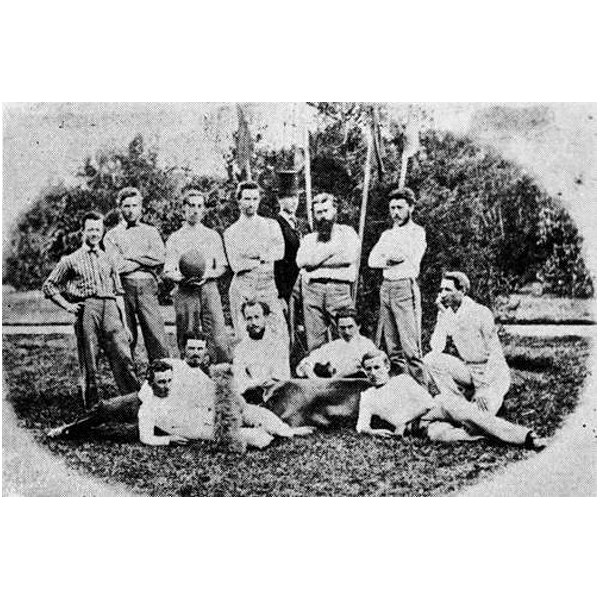
Soccer Team Brisbane 1870
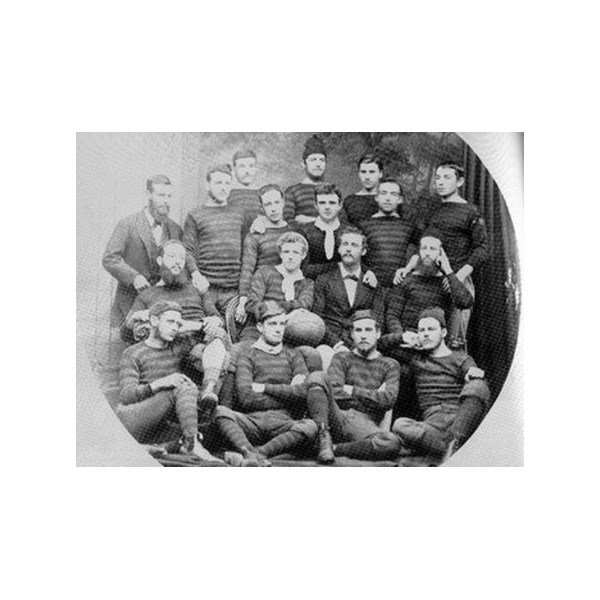
Brisbane Football Club 1879 playing Melbourne Rules and Rugby rules
As
well as the
Brisbane Football Club, the only other known
Brisbane club at the time was the Rangers Football Club (formed in 1876), both of which were now playing according to both the
Melbourne Rules and the Rugby Union rules.
It also appears that
Brisbane FC played at least one game of 'London Association Football' ('soccer'): The Queenslander of 14 August 1875 reported that on Saturday 7 August 1875,
Brisbane FC played a game against the inmates and warders of the Woogaroo Lunatic Asylum (now 'The
Park Centre for Mental Health Treatment, Research & Education' at Wolston
Park, near Goodna): "… play commenced at half-past 2 ... One rule provided that the ball should not be handled nor carried." This evidence is corroborated by the Victorian publication The Footballer, which reported in 1875 in its section on "Football in Queensland" that "the match was played without handling the ball under any circumstances whatever (Association rules). This is the earliest known game of 'soccer' played in the
Brisbane region (and possibly in Australia) - regular games of 'soccer' did not commence in
Brisbane until 1884.
The first known club formed to play under Association Football rules in
Brisbane was the Rangers Football Club, formed in 1883.

Bundamba Rangers 1895
This decade was a boom period for immigration in the colony , Between 1881 and 1891 metropolitan
Brisbane's
population grew from 37,000 to 100,000. The first reported association football matches were played by a group who originally practised at Queen's
Park (now part of the
Brisbane City Botanic Gardens), on the flat area near the
Brisbane River, adjacent to Alice Street and between Edward and Albert Streets, around 1883. These players were presumably mostly recent Scottish migrants, given they were referred to as 'Scotch rulers' by players of the other codes, as
well as the team names they eventually adopted. After disagreements over ground-sharing with cricketers and the Rugby Union and
Melbourne Rules players, they sought another ground. Eventually, they received permission from the publican of the Pineapple Hotel, almost directly across the river at
Kangaroo Point, to play at his 'Pineapple Sportsground' behind the hotel (this ground is now part of Raymond
Park).
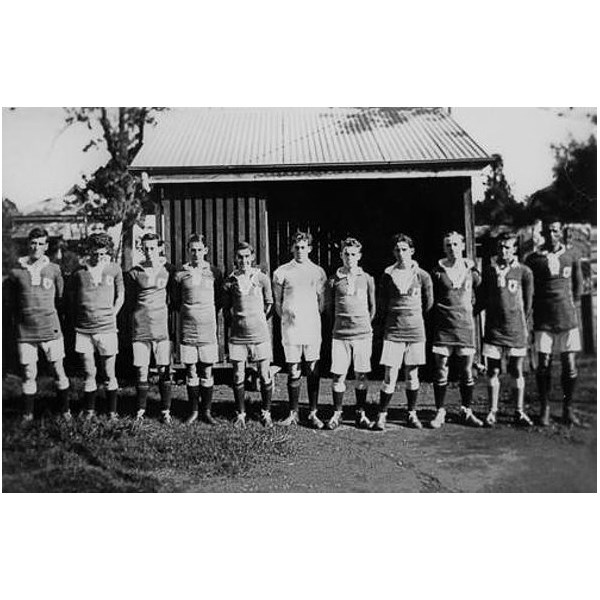
Pineapple Rovers 1924
The first match under the auspices of the Anglo-Queensland Football Association took place on the Pineapple Ground,
Kangaroo Point on Saturday, the contending clubs being the Queen's
Park and St Andrew's. The clubs played eleven aside, being the usual number in matches under this association. The colours were-for St Andrews dark blue and for Queen's
Park blue and white. Mr Shiers was umpire for the Queen's
Park, and Mr Curry filled the same position for the other side, Mr Hudson being referee. The attendance numbered about sixty, and most of them took a lively interest in the game.
The game progressed the following year, as at least two of the clubs had second teams: a newspaper report in late 1885 described "Second Rangers" defeating "Second Queen's Park" 2-1 "at the Pine Apple ground". Whilst there are no known records of organised games under ‘Association’ rules prior to the 1884 season, a speech at the Queen's
Park Football Club annual dinner at the end of the 1885 season by Mr Pring Roberts suggests there may have been earlier games. Mr Roberts acknowledged "the increasing popularity of the [Association football] game in the metropolis and the great strides made since its revival by the Anglo-Football Association some two seasons ago .
By 1886, the game was rapidly becoming popular, as around 400 spectators watched as Queen's
Park hosted St Andrew's for the opening match of the season, with Saint Andrew's winning 7-0 (including an own goal). Other matches reported in August 1886 included St Andrew's 5-1 against the Rangers at 'The Pineapple', Second St Andrew's 3-1 against Swifts at Albert
Park and the newly formed Bundamba Rovers 3-1 against Queenslanders at Bundamba. St Andrew's went on to win all of its 10 matches during the 1886 season and became "premier club and the winners of the association badges.
Matches between
Brisbane and
Ipswich teams were made possible by the
Brisbane to
Ipswich railway line, which had opened in 1876 (
Ipswich, about 40 kilometres south-west of
Brisbane, was where many Welsh and northern English coal miners had settled from the mid-nineteenth century onwards). The Thistle Football Club, a breakaway group from the St Andrew's club, joined the competition in 1887 and went on to win the AQFA Cup final the following year, defeating Bundamba Rovers 5-1 at the "Five Ways, Woolloongabba [now the
Brisbane Cricket Ground]. In front of 300 spectators .
However, and unfortunately for the progress of the Association game, the Northern Rugby Union (NRU) was also formed in 1884, as a breakaway from the Queensland Football Association (the body which administered both Victorian Rules and Rugby at that time). Within two years, the NRU competition had six teams and, according to one writer, "The defining moment in the code battle came with the 1886 Queensland [Rugby] side, who defeated NSW for the first time in
Sydney. "The success of this team undoubtedly won the day for rugby game in Queensland. The Victorian game supporters were struggling hard to uphold the premier position they had gained but after the brilliant performance of the 1886 team, who lost only one match through their tour, the rugby game became very popular and the next season several new clubs were formed and the Victorian game began to wane". Inspired by this performance, schools started to change to Rugby and by 1887 the NRU boasted 25 clubs.
Toward the end of the 1880s, a newspaper reported regarding the state of football in the colony: "Rugby, an unbounded success;
Melbourne rules very sick indeed, in fact on their last legs; British Association Rules, also in a sickly state but if anything showing more life than the Victorian game." At the QRU annual meeting in 1894, it was asserted that "the football game of Queensland was undoubtedly rugby. There were no signs that any other game was likely to become so popular as it.
The 1920s decade was pivotal for the development of all of the football codes in
Brisbane, where Rugby Union had been the dominant code since the mid-1880s. According to the official Queensland Rugby Union history, after the advent of Rugby League in
Brisbane in 1908, Rugby union took a downturn in Queensland.... The effect of league developing, compounded with the First World War, was immediate and strong with major clubs and the GPS schools all changing to Rugby league in 1918, which effectively led to the disbandment of the Queensland Rugby Union in 1919. The Rugby Union did not re-form until 1928, but by this time Rugby League had become the dominant football code in
Brisbane , a situation that exists to this day.
Another notable event in 1921 was the formation of the Queensland Ladies Soccer Football Association, at a meeting held in the
Brisbane Gymnasium, at which "about 100 ladies were present. It appears that three clubs were formed and played 'friendly' matches during the season:
Latrobe Ladies , North
Brisbane and South
Brisbane. Remarkably, about 10,000 spectators attended at the
Brisbane Cricket Ground in September 1921, to see North
Brisbane defeat South
Brisbane 2-0 in their first game. The annual meeting of the association in 1922 expressed the desire to commence regular fixtures during the forthcoming season with "about half a dozen teams". However, apart from a practice match between the '
Brisbane City' and '
Brisbane Ladies' clubs at
Bowen Park in June 1922 (which City won 12-0), there are no known records of the progress of this association after that time.
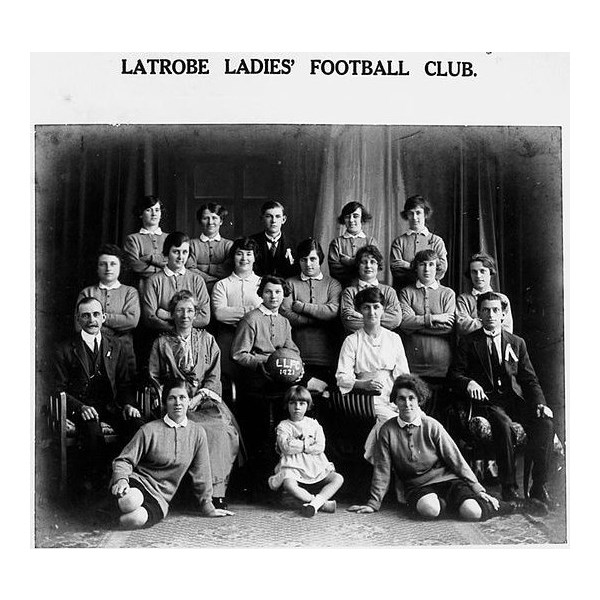
Latrobe Ladies Soccer Team 1921
Matters deteriorated in 1929, when the three
Ipswich clubs (Bundamba Rangers, Dinmore Bush Rats and
St Helens) withdrew from the semi-final round, leaving only
Brisbane club
Latrobe. The reason given in a newspaper report was "because they were not allowed to share the profits of the matches which were to have been played at the Cricket Ground." However, the report also noted "they were parties to the original arrangement ... The four
Brisbane clubs alone are responsible for the rent of the
Brisbane Cricket Ground, and these semi-finals were to help liquidate the liability. Another report said "the whole future of the game in this State is in the melting pot. To put the matter bluntly, the
Brisbane clubs are fed up with these incessant rows with
Ipswich, and desire to end the business once and for all The
Ipswich clubs were fined and suspended and, despite attempts at mediation, were not included in the
Brisbane competition for 1930 . With the departure of the
Ipswich clubs,
Latrobe became the dominant team of the late 1920s and early 1930s, winning six of the seven Premierships .
In 1935, the Queensland Soccer Council (QSC) had taken over the lease of Lang
Park as its home ground, with a view to using it as the home ground for BDFA fixtures (and thus leaving the
Brisbane Cricket Ground)
Latrobe became a sub-tenant, using the ground for its home games. However, by 1937, the QSC was considering sub-leasing Lang
Park to "another code of football" (most likely Western Suburbs Rugby League) as it "was not satisfied with the financial returns ... under the sub-lease to the
Latrobe-
Milton club".
Latrobe in turn responded that "'If no action Is taken to introduce the
Ipswich clubs into the
Brisbane competition this' season ... the
Latrobe-
Milton Club cannot accept an increase in rental for Lang
Park. Give us competition play with
Ipswich and my club will hold the ground as headquarters for the code. The matter was resolved after much negotiation between the QSC and the tenant clubs, which could explain the QSC's decision to merge the
Brisbane and
Ipswich associations for the 1937 season, when the
Ipswich and
Brisbane teams resumed competition together for the first time since 1929.
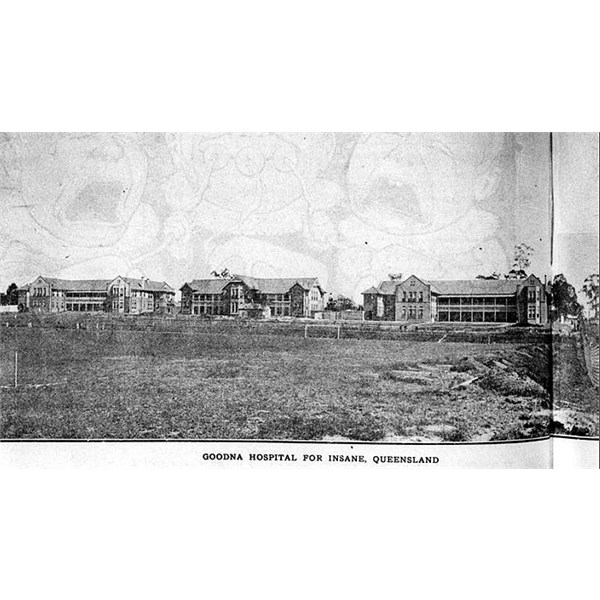
Goodna Woogaroo Asylum 1919, showing football field in the foreground
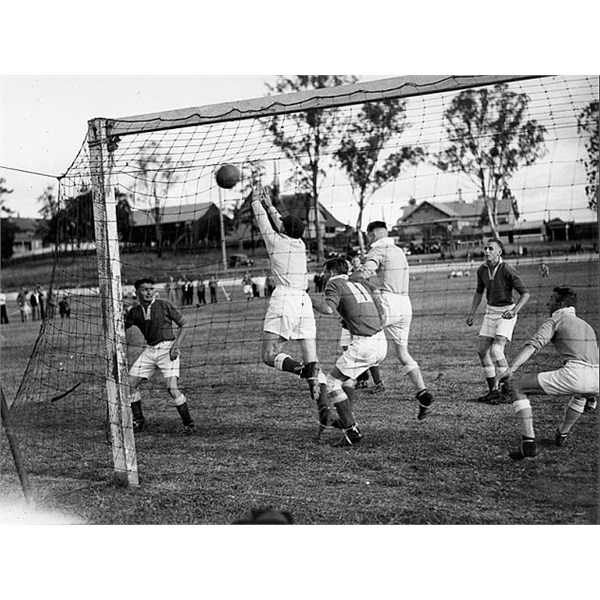
1937 soccer match at Lang Park Milton, looking towards Milton Road.
For the 1940 season, there was further change, with a proposal for the establishment of a 'district' competition (which was not ultimately adopted). That year also saw the formation of the Queensland Soccer Football Association (QSFA) and more problems for the game: the major
Ipswich clubs (Blackstone, Booval Stars, Bundamba Rangers and St. Helens) initially decided not to affiliate with the QSFA, as they considered it was "unconstitutional". Despite this, they decided this would not "break up any likely conference with the A grade clubs of
Brisbane. The
Ipswich teams, with the exception of
St Helens, ultimately joined the
Brisbane competition for that year, with some of the
St Helens players joining
Brisbane clubs to continue their playing careers.
Latrobe boasted "four international players", including two former Bundamba players, which suggests that
Latrobe (if not other clubs as
well) was operating on a semi-professional basis, in order to attract players from relatively distant locations (despite this being 'illegal' under the QSFA rules . A newspaper article in 1940 appears to confirm this by reporting criticism of "certain first division clubs ... [which] continued to offer inducements to younger players to leave the club (whilst there is no known evidence, the experiences of other football codes and competitions suggest it is likely that 'illegal' payments (often referred to as boot money)' were paid to players from early days of the competitions).
The 1946 season opened brightly, with 31 teams contesting
Brisbane senior competitions in three divisions. The First Division comprised ten teams, Blackstone Rovers, Booval Stars, Bundamba, Corinthians (Langlands
Park, Greenslopes), Eastern Suburbs (Heath
Park, East
Brisbane),
Latrobe (
Gregory Park,
Milton),
St Helens (Ebbw Vale), Thistle (Lanham
Park, The Grange), Shafston Rovers (Raymond
Park,
Kangaroo Point) and Y.M.C.A., and the Second and Third Divisions twelve and nine teams respectively. The Y.M.C.A team subsequently won the First Division Premiership narrowly over Blackstone Rovers.
The
Ipswich domination of the football competition continued after the war, with its clubs (in particular
St Helens, Dinmore Bushrats and Bundamba Rangers) winning eight of the premierships between 1946 and 1959. The quality of
Ipswich football at the time is evidenced by the inclusion of four of its players in the Australian team at the 1956 Olympics in
Melbourne: Brian "Chookie" Vogler, Al Warren,
Cliff Sander and Col Kitching. A fifth player,
Gordon 'Bunny' Nunn who, despite 33 previous appearances for his country, was ruled ineligible because he had turned 'professional' when he joined a
Brisbane club (Caledonian) "for pound stg. 1 and threepence a game" in 1953. Australia defeated Japan 2-0, but was knocked out in the quarter-finals by India 4-2, after two Australian goals were disallowed.
However, the
Ipswich domination was not to last: according to one source, the advent of wealthy ethnic clubs in
Brisbane in the 1950s and 60s led to the decline of football in
Ipswich, through those clubs attracting the best
Ipswich players (including Brian Vogler, who had "been lured to the big-spending
Brisbane club Hellenic" and also to "the birth of professionalism in Queensland soccer. However, the
Ipswich 'decline' may have started as early as 1940
After the war, as part of a "populate or perish" policy, the Australian Government initiated an assisted migration program, which continued until 1973. As
well as British and Irish migrants, the government sponsored migrants from European countries, particularly Italy, Greece, Germany and Turkey. As association football was the overwhelmingly dominant sport in the British Isles and Europe, these people swelled the ranks of players and supporters in Australia and formed their own ethnic-based social clubs and football teams. In
Brisbane, the larger ethnic groups produced strong teams, such as Azzurri (Italian, now
Brisbane City at Newmarket), Budapest-Grovely (Hungarian, now Westside at Grovely), Dnipro (Ukrainian, now defunct), Germania (German, now Southside Eagles at Bulimba), Hellenic (Greek, later
St George South (after name changes required by the QSF), Hollandia (Dutch, now Lions FC at Richlands) and Polonia (Polish, now defunct). As as
well as this, for many years
Latrobe (now Bardon
Latrobe at Bardon) predominantly comprised British and Irish players (
Latrobe manager William 'Pop' Harper, himself a British migrant in the early 1900s, encouraged migrants with offers of jobs, accommodation and semi-professional football). Indeed, from 1960 to 1978 inclusive, every
Brisbane First Division Premiership was won by an ethnic-based club: Azzurri (now
Brisbane City), Germania (Southside Eagles), Hellenic (
St George South), Hollandia (Lions FC) and
Latrobe (Bardon
Latrobe).
The early 1960s saw the local game in turmoil once again: The eight first division clubs broke away from the Queensland Soccer Football Association and joined the newly-formed Queensland Soccer Federation (QSF). The remaining clubs ultimately joined the QSF and it became the peak body for football in Queensland, until the formation of '
Brisbane Men's Soccer' in 2003.
In the interest of inclusiveness and because perceptions that members of the public saw football as a migrants' game, all clubs were required to adopt non-ethnic names after a ruling by the QSF in 1973. The National Soccer League (NSL) commenced in 1977, with fourteen teams from the Australian Capital Territory, New South Wales, Queensland, South Australia and Victoria. The two teams from
Brisbane -
Brisbane Lions (formerly Hollandia, with their home ground at Richlands) and
Brisbane City (formerly Azzurri SFC, with their home ground at Spencer
Park, Newmarket) finished ninth and tenth respectively. Neither club succeeded in winning the championship, but did win the NSL cup (
Brisbane City in 1977 and 1978,
Brisbane Lions in 1981).
A significant development for football and adversely for Rugby Union was the establishment of the game as an official sport in the private schools in the early 1990s , Anecdotally, this move was very strongly resisted by the Rugby fraternity in the schools, as they wished to maintain what was perceived as the traditions of amateur football (Rugby was not to become a professional game officially until 1995). Since that time, the game has developed such that many schools now have as many football teams as they have Rugby teams.
The oldest extant club in continuous existence appears to be Oxley
United FC (formerly Oxley Soccer Club and Oxley Ramblers) which, according to club records, was established in 1912 or 1913. Oxley first appears in news reports for
Brisbane football in 1918, then joined the
Ipswich association in 1930 and rejoined the combined
Brisbane-
Ipswich association in 1937, in which it has played continuously to date. Oxley club reached its
pinnacle in the late 1950s, winning the First Division premiership and a number of cup and shield competitions. The club now plays at Dunlop
Park, Corinda.
Toowong Football Club is reported as early as 1911, however it is uncertain which football code it was playing. The first results recorded for a Toowong ‘soccer’ club were in 1913, whilst reports also refer to a Toowong Caledonians 'soccer' club and a 'new' Toowong senior club forming in the early 1920s. However, Toowong clubs appear to have disbanded then re-formed a few times over the decades. The modern Toowong club plays at Dunmore
Park, Auchenflower.
The oldest extant club that has played continuously in
Brisbane senior men's competitions appears to be Wynnum, which entered the
Brisbane First Division in 1921, the year the club was formed. The club is now known as Wolves FC and plays at Carmichael
Park, Tingalpa.
The oldest club that has played continuously in
Brisbane competitions appears to be Bardon
Latrobe. The
Latrobe club first appears in newspaper reports in 1917, playing at
Gregory Park (adjacent to the
Milton State School). After mergers and de-mergers with the
Milton (1930s) and Bardon (1941) clubs, the club merged with Bardon again in 1970, and commenced playing at
Bowman Park Bardon (the original Bardon club's home ground). The senior section of the club then went through a further merger with the Mitchelton football club, with some players rejoining to form Bardon
Latrobe senior teams in the late 1970s through to the early 1980s. From the mid-1990s, the club played only in
Brisbane junior competitions, but in 2011 rejoined the ranks of senior mens football, with a team in the
Brisbane Metropolitan League.
The oldest club in its original form and still using its original name that has played continuously in the
Brisbane senior competitions appears to be Taringa Rovers, formed in 1949. The club plays at Jack Speare
Park at Indooroopilly, where it has been since 1955.
The
Brisbane Broncos are an Australian professional rugby league football club based in the city of
Brisbane, Founded in 1988, the Broncos play in Australasia's elite competition, the National Rugby League (NRL) premiership. They have won six premierships and two World Club Challenges. The Broncos have achieved four minor premierships during their 22 years in competition, making them the League's most successful club over the past two decades. They are the most successful club since the National Rugby League began in 1998, winning three premierships in this era. In 2010,
Brisbane finished 10th in the NRL premiership, failing to make the semi finals for the first time in 19 years. They are also one of the most successful club in the history of Rugby League, having won 63% of their games since their induction in 1988, second only to
Melbourne Storm with 64%.
.